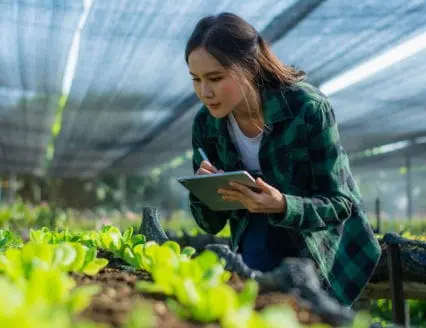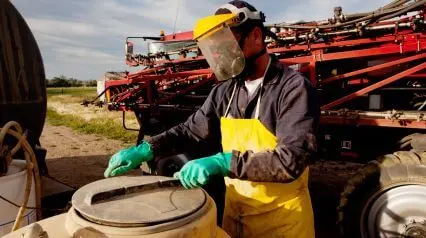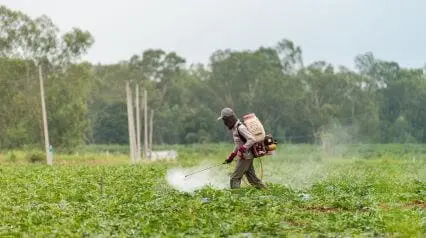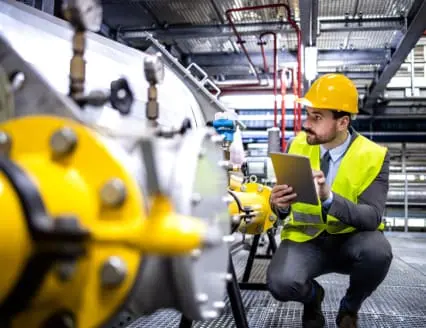What is Smart Farming?
Smart farming is a practice in agricultural production that involves using technology like IoT, robotics, drones, and AI, among others, to manage farms, increase output, and reduce environmental impacts. Smart farming’s goal is to increase both the quality and quantity of farming products while optimizing human labor to ensure the best possible results.
Farms and agricultural sites that utilize smart farming techniques are known as smart farms. These farms typically utilize new tools such as sensors that monitor weather round the clock and mobile inspection apps that help farmers improve their agricultural practices to increase their produce while supporting sustainability and maintaining product quality.
Example
With all the new technology available at our finger tips, there are many ways farms can create smarter, more productive, and more sustainable processes. A clear example of smart farming that you can see in many farms today is the use of sensors to monitor parameters like soil quality, light levels, ambient temperature, and humidity. That way, workers know exactly what the plants would need to have the best quality and quantity during harvest without wasting or using too many resources.
Another example of smart farming is the use of AI and autonomous machines to perform certain tasks. For example, many modern farms have begun using autonomous tractors that don’t require a human to control it. That way, human labor can be used for other tasks while the tractors perform their job autonomously, safely, and effectively.
Many farms have also started adopting different software that utilizes IoT for even more efficient operations. Through these setups, farm managers can control various aspects of the farm through a smart device or a computer, greatly reducing the need for manual labor.
Traditional vs Smart Farming
A great way to fully grasp the concept of smart farming and its importance is by comparing it to traditional farming methods. While farming itself was a huge innovation for humankind and allowed us to further grow as a species, traditional farming methods are slowly becoming outdated and inefficient.
For example, in traditional farming, much of the labor needs to be done manually. This includes planting crops, maintaining them, and harvesting them at the end of the cycle. This method involves many more resources and can result in a lot of waste, which is why the agricultural sector has a major effect on our environment.
However, with an IoT-powered system, farms can drastically reduce the amount of manual labor needed while increasing precision. On top of that, it gives farmers much more precise control over their crops and resources. This allows you to only your resources when needed and produce much higher-quality crops without producing that much waste.
Currently, we’re seeing a shift in traditional farming methods into more technology-driven practices. This holds a huge potential for the industry as not only does it reduce waste and the heavy environmental impact of farming, but it improves crop quality and quantity, helping farmers become more flexible to shifting demands and stay compliant to regulations concerning good agricultural practices.
Implement SafetyCulture In Your Smart Farming operations
Eliminate manual tasks and streamline your operations.
Get started for FREEHow IoT Affects the Farming Cycle
The traditional farming cycle is quite straightforward and easy to understand. And while IoT and smart farming can affect this cycle, it doesn’t change it that much. The entire goal of IoT is to collect data and input, which is then transported over the internet to another device.
That way, any issues or problems that the IoT sensors catch are reported immediately, giving the farmers a clearer window for them to act on the problems. So, under an IoT or smart system, the farming cycle will look something like this:
Observation – The process begins with sensors and other devices observing soil conditions, temperature, humidity, and other parameters. From there, it records the data that it observes.
Diagnosis – After the data is transmitted via the internet, the IoT platform will decide the best course of action. These platforms are equipped with complex algorithms that are able to dictate the best action based on specific observations.
Decision – The next step is deciding which specific action to take based on the data. This could be done by a person or a machine-learning system. Alternatively, both the AI IoT platform and the user can work together to figure out if the action is necessary and which specific action to take.
Action – Once the decision has been made, the next step is to actually perform the said actions. Again, this could be done by a team of robots, autonomous machines, humans, or a mix of all three.
Different IoT Smart Farming Solutions
Here are some of the different farming solutions present in a Smart Farming system.
Agricultural Drones
Agricultural drones have made major steps in recent years. To start, drone technology has become much more accessible, practical, and effective. So, farmers can now use agricultural drones for getting a bird’s eye view of an area and get a visual on a specific location quickly. These drones allow farmers and teams to work quickly and more efficiently, which has a huge impact on the entire agricultural process.
Modern drones may also be used to gather temperature, humidity, atmosphere, and even soil data. And again, smart farms rely heavily on large and accurate data sets to come up with the best course of action.
Precision Agriculture
Precision agriculture or precision farming is another area of smart farming. This type of system relies on large data sets that can be used to determine which crops to plant, how to plant them, and how to do so in the most efficient manner. This can allow for a much more sustainable farming system that will have a smaller impact on the environment.
Automations
Automations are another way that smart farms are growing worldwide. A clear example of this is the use of sensors in gathering soil, temperature, humidity, and atmosphere data. These sensors can transmit data over the internet so you get a real-time view of the conditions of a farm and be notified if urgent action is needed.
This allows managers to make more accurate and informed decisions over how much fertilizer to use, what type of nutrients the plants need, and more.
Another way automation is used is in autonomous machines. These machines can be programmed to perform specific tasks at different times such as watering, fertilizing, or even planting crops. This reduces human labor as well as the necessary resources for planting different crops.
FAQs about Smart Farming
Some people claim that smart farming traces its roots back to the 1990s when tractors began using GPS and satellite maps. However, there are other schools of thought that believe smart farming truly began in 2009.
There isn’t a single person or group that came up with smart farming. Instead, the concept of smart farming can be seen as a natural evolution of agriculture itself as humans have become better at gathering data and applying it in the real world.
Many countries have begun to shift to a smart farming system. Some of these countries include Vietnam, Tanzania, US, UK, Japan, numerous EU countries like Germany, and more.
Smart farming systems are still in development and aren’t perfect. This means that the systems can sometimes result in the use of more chemicals, soil damage, increased food miles, and uneven water distribution.




